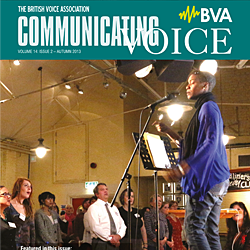About the Association
Archived newsletter articles
'Interactive Rock & Pop Day'
4th September 2007, Royal Academy of Music, London
British Voice Association event report – by Sue Anderson
The industrial action of London underground drivers did not strike at the heart of this popular event, and in the end only 2 out of 88 participants were unable to attend. I decided that Victoria station was best left to the commuters until after 9 am, and so I missed the excellent singing of Lail Arad, which provoked the response 'Wow, a lovely start!' on one of the feedback forms. 'Rough and Ready – Safe or Sorry!!!!' was the title chosen by Tom and Sara Harris to introduce the audience to the work of the Voice Clinic team at Sidcup. Tom, whose delivery led one delegate to ask if he had been moonlighting on the comedy circuit, gave good basic information about vocal health, for example, when to seek help, what specialist help is available, and, most importantly, how to get to that help if at all possible. The standard format of vocal examination within a specialist clinic was described, and then possible treatment routes were considered. Which all led seamlessly into the presentation by Sara Harris, describing the role of the Speech and Language Therapist in the assessment and treatment of singers in distress. The Sidcup triumvirate was completed by Jacob Lieberman, who used very effective video footage to illustrate the rationale and results from Laryngeal Manipulation.
For many of the delegates, particularly the very welcome cohort of students who are just beginning the Music Theatre course at RAM, much of the content presented was new, stimulating, and immediately relevant. For those of us more familiar with this information, gained by attending many BVA events, the honesty of Alice Russell's conversation with Tom Harris and Maureen Scott, ENT surgeon and teacher respectively, firmly linked the personal perspective to the theoretical knowledge. With a great voice and tremendous personality, we really were convinced that 'There is life after surgery'!
For me one of the revelations of the day was Daniel Zangger Borch, who somehow managed to combine firmly grounded scientific research with an informative, entertaining and highly engaging delivery style. On the back cover of his new book 'Ultimate Vocal Voyage' he is described as the 'first Swedish singing voice specialist to scientifically study the functioning of the rock, pop and soul voice', and he presented some of the exercises contained in the book – deceptively simple yet specific and effective. No wonder Maureen had been saying 'we must have Daniel back' ever since he came to the last three-day BVA Pop & Rock event!
After the break Kim Chandler introduced another set of exercises, which use extracts from a wide variety of genres as hooks for 'funky' warm ups. Once again, great communication skills were linked with sound technical and musical ability. The drier presentation of Ed Blake and Jane Grey, showing the use of ultrasound imaging for breath support, needed a minor adjustment in concentration levels, but the material linking muscle recruitment with appropriate sub-glottic pressure proved to be of great interest to many of the delegates. The final item before lunch was Dane Chalfin de-mystifying the 'mix', a term that I was unfamiliar with as a classically–trained singer straying into the Pop & Rock Day. Once again, Dane is engaged in on-going research about this topic, and it is clear that there is now far more eagerness to question and look for answers by members of the singing fraternity themselves, surely an extremely healthy sign!
In the afternoon two singers, Lorna Forsyth and Shèna Washington, were interviewed about their careers; Lorna as a singer who also taught, and Shèna as a very busy solo and backing singer with a young baby. Insights and practical advice were gleaned from both artists, and Shèna in particular was very responsive in the question and answer session. The honesty and humility shown by 'H' from 'Steps' in interview was remarkable, and hearing him talking about going back to basics and enrolling at the Royal Academy of Music after the success he had experienced with 'Steps' and as 'Joseph' in the West End was extraordinary. The final two sessions of the day were the promised interactive part, with choreographer David Leighton producing remarkable results from a non-selected group up on stage, and then almost all delegates joined in a rehearsal of Dancing Queen led by Tony Castro.
As a singer and teacher who has had very little contact with the Pop & Rock world, it was a fascinating day, and it has certainly made me listen with new ears to these genres. I was impressed above all by the enthusiasm, honesty and dedication demonstrated by all the speakers and singers, striving to communicate sincerely and effectively with their public. From an audience perspective, the organisation of the day was brilliant from start to finish, for which enormous thanks must go to Maureen Scott, aided by Dane Chalfin and Kim Chandler. The indefatigable pianist for the day was Stuart Morley.
Report by Alison Alcock (student)
The interactive rock and pop day was situated in the Jack Lyons theatre at the Royal Academy of Music. The timetable consisted of a variety of workshops and presentations, providing an insight into many areas of the pop industry, and its demands on the performer.
The day commenced with a performance by Lail Arad, which although not to my taste was original and entertaining all the same. A comical presentation by Tom Harris about maintaining vocal health made the audience laugh, followed by Sarah Harris who discussed the role of the speech and language therapist for singers and how they provide basic treatment ready for the singing teacher to 'fine tune'. Jacob Lieberman presented evidence for the positive effect of laryngeal manipulation on the voice following just 15 minutes of therapy. Ed Blake and Jane Grey conducted a workshop on the breathing mechanism. A real time ultrasound scan was conducted on a volunteer for us to see the working of the internal and external obliques whilst performing the 'siren' and other singing exercises. It was interesting to see the different muscles working on the scan, but unfortunately, the more theoretical side of this presentation was a little bit above me and I found it quite difficult to understand.
The more interactive part of the day began with Daniel Zangger Borch's inspirational workshop. We performed some creative exercises designed to develop vocal technique as well as musicality. We used the exercises to produce different voice qualities, but as all sessions were quite short, we were only able to do a few exercises. However, Daniel's book was available, which I purchased, as I wanted to learn more! Kim Chandler followed this with a song based approach to popular music. Using well known melodies to develop vocal flexibility exercises, she encouraged the audience to 'look outside the box' and try developing some of these themselves.
There were several interviews with professional singers throughout the afternoon, including Ian Watkins, formerly known as 'H' from Steps. This was very interesting, as they explained how this career is not all glamour, and compromises have to be made. Maureen Scott and Tom Harris also talked about recovery after surgery with Alice Russell, who has had vocal surgery and yet gave a stunning performance with her guitarist. It was reassuring to know that vocal surgery does not mean the end of a career in singing. There were also interviews with managers and engineers who spoke about the music industry from their perspective. All interviewees were very open, giving an honest account of how they view the industry.
Choreographer David Leighton gathered willing volunteers from the audience to show the difficulty of singing whilst dancing. The girls learned a routine but found that it was difficult to sustain vocal technique whilst concentrating on the routine.
One workshop which left me quite confused was Dane Chalfin's presentation on 'the mix' as I had never come across this before. This was described by various people as being the point between the head and chest voice. I have not heard the terms head and chest voice since my early training, and whilst learning the Estill technique these terminologies have not arisen. Therefore, I was unsure of what was being shown during this session as I have learned in my recent training that there should be a continuous core quality kept throughout the range without the definite split between head and chest voice.
The day concluded with a 'sing along' of Dancing Queen with Tony Castro giving us a great opportunity to apply all the techniques that had been explained and demonstrated throughout the day. This ended the day on a high and I thoroughly enjoyed myself!
More archived content online
Disclaimer
Neither the British Voice Association nor the Editor can be held responsible for errors or any consequences arising from the use of information contained in its newsletters (or extracts from its newsletters published online); the views and opinions expressed do not necessarily reflect those of the British Voice Association (BVA) or the Editor, neither does the publication of advertisements constitute any endorsement by the BVA or Editor of any products or services featured.

 Join us Now!
Join us Now! our newsletter
our newsletter free voice care leaflets & information – download here
free voice care leaflets & information – download here Help our work by donating while you shop
Help our work by donating while you shop